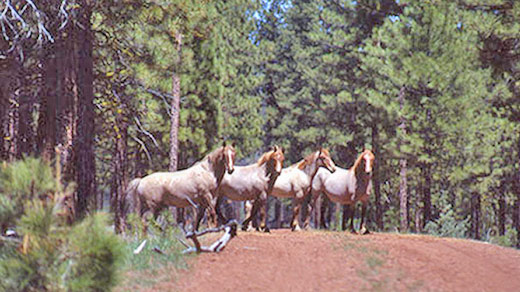Devil's Garden Horses: Background
 The Devil's Garden Plateau WHT is located in California approximately seven miles north of Alturas. The territory consists of 258,000 acres; 248,428 acres of Forest Service land, 7,632 acres of public lands administered by the Bureau of Land Management's Applegate Field Office (BLM) is included in the territory. Approximately 800 acres of Tribal Lands, 640 acres of California State Lands and 500 acres of private lands fall within the territorial boundaries; however, these lands are excluded from the territory.
The Devil's Garden Plateau WHT is located in California approximately seven miles north of Alturas. The territory consists of 258,000 acres; 248,428 acres of Forest Service land, 7,632 acres of public lands administered by the Bureau of Land Management's Applegate Field Office (BLM) is included in the territory. Approximately 800 acres of Tribal Lands, 640 acres of California State Lands and 500 acres of private lands fall within the territorial boundaries; however, these lands are excluded from the territory.
The topography is a relatively flat continuous lava plateau. Average elevation is 5,000 feet. Precipitation is primarily from winter snow between November and March. Average annual precipitation is 12.6 inches. Temperatures during winter can be severe for short periods of time, and summer temperatures frequently exceed 90° Fahrenheit.
Vegetation is typical of high desert plateau sagebrush-steppe ecosystems. It is fairly uniform and consists primarily of western juniper, big sagebrush, perennial grasses, and increasing invasive annual grasses.
Wildlife present within the territory includes deer, antelope, cougar, rabbits, rodents, migratory birds and aquatic species dependent on delicate high-desert riparian areas.
The entire territory is within permitted livestock allotments.
History
Wild horses have been present on the Devil's Garden Plateau since shortly after the first pioneers arrived. Many of the early horses escaped or were released when their usefulness as domestic animals ended. The first roundup occurred as early as 1889. In later years, local ranchers and native tribal members turned horses out to graze and then gathered them as needed. Devil's Garden Horses contributed to the liberation of Europe in WWI. Not all were ever captured. With the passage of the 1971 Wild Horse and Burro Act (PL 92-195), private horse roundups ended. In 1974, as an initial step toward management, the Forest Service inventoried the Devil’s Garden Wild Horse population for the first time. The new Devil's Garden Plateau Wild Horse Territory Management Plan, completed in 2013, set an Appropriate Management Level (AML) of a maximum of 402 total horses.
Herd Description
Horses can be seen in many colors and sizes. The dominant colors are roan, black and bay; however, gray, buckskin, palomino, and sorrel are also found with some frequency. DGs are well known to be even minded, large, colorful and great companions at any age.
For More Information
Visit the Modoc National Forest website for the Devil’s Garden Plateau Wild Horse Territory.


